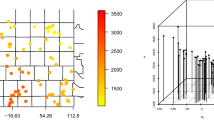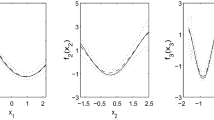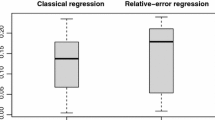Abstract
This paper considers a varying coefficient partially linear regression with spatial data. A general formulation is used to treat mean regression, median regression, quantile regression and robust mean regression in one setting. The parametric estimators of the model are obtained through piecewise local polynomial approximation of the nonparametric coefficient functions. The local estimators of unknown coefficient functions are obtained by replacing the parameters in model with their estimators and using local linear approximations.The asymptotic distribution of the estimator of the unknown parameter vector is established. The asymptotic distributions of the estimators of the unknown coefficient functions at both interior and boundary points are also derived. Finite sample properties of our procedures are studied through Monte Carlo simulations. A real data example about spatial soil data is used to illustrate our proposed methodology.




Similar content being viewed by others
References
Athreya KB, Pantala SG (1986) A note on strong mixing of ARMA processes. Stat Probab Lett 4:187–190
Carbon M, Tran LT, Wu B (1997) Kernel density estimation for random fields. Stat Probab Lett 36:115–125
Chen H (1988) Convergence rates for parametric components in a partly linear model. Ann Stat 16:136–146
Chen K, Jin Z (2006) Partial linear regression models for clustered data. J Am Stat Assoc 101:195–204
Cressie NAC (1991) Statistics for spatial data. Wiley, New York
Fan J, Huang T (2005) Profile likelihood inferences on semiparametric varyingcoefficient partially linear models. Bernoulli 11:1031–1057
Gao J, Lu Z, Tjøstheim D (2006) Estimation in semiparametric spatial regression. Ann Stat 34:1395–1435
Hallin M, Lu Z, Tran LT (2001) Density estimation for spatial linear processes. Bernoulli 7:657–668
Hallin M, Lu Z, Tran LT (2004a) Density estimation for spatial processes: the L1 theory. J Multivar Anal 88:61–75
Hallin M, Lu Z, Tran LT (2004b) Local linear spatial regression. Ann Stat 32:2469–2500
Hallin M, Lu Z, Yu K (2009) Local linear spatial quantile regression. Bernoulli 15:659–686
Hampel FR, Ronchetti EM, Rousseeuw PJ, Stahel WA (1986) Robust statistics, the approach based on influence functions. Wiley, New York
Hardle W (1990) Applied nonparametric regression. Cambridge University Press, Cambridge
He X, Zhu Z, Fung WK (2002) Estimation in a semiparametric model for longitudinal data with unspecified dependence structure. Biometrika 89:579–590
Kai B, Li R, Zou H (2011) New efficient estimation and variable selection methods for semiparametric varying-coefficient partially linear models. Ann Stat 39:305–332
Kavousi A, Meshkani M, Mohammadzadeh M (2011) Spatial analysis of auto-multivariate lattice data. Stat Pap 52:937–952
Koenker R (2005) Quantile regression. Cambridge University Press, Cambridge
Koenker R, Basset G (1978) Regression quantiles. Econometrica 46:33–50
Lee YK, Choi H, Park BU, Yu KS (2004) Local likelihood density estimation on random fields. Stat Probab Lett 68:347–357
Li D, Chen J, Lin Z (2011) Statistical inference in partially time-varying coefficient models. J Stat Plan Inference 141:995–1013
Lin Z, Li D, Gao J (2009) Local linear M-estimation in nonparametric spatial regression. J Time Ser Anal 30:286–314
Lu Z, Cheng P (2004) Spatial kernel regression estimation: weak consistency. Stat Probab Lett 68:125–136
Lu Z, Lundervold A, Tjøstheim D, Yao Q (2007) Exploring spatial nonlinearity using additive approximation. Bernoulli 13:447–472
Lu Z, Tang Q, Cheng L (2014) Estimating spatial quantile regression with functional coefficients: a robust semiparametric framework. Bernoulli 20:164–189
Ripley B (1981) Spatial statistics. Wiley, New York
Rosenblatt M (1956) A central limit theorem and a strong mixing condition. Proceedings of the National Academy of Sciences of the USA 42:43–47
Tang Q (2010) \(L_{1}\)-estimation in a semiparametric model with longitudinal data. J Stat Plan Inference 140:393–405
Tang Q, Cheng L (2009) B-spline estimation for varying coefficient regression with spatial data. Sci Chin Ser A 52(11):2321–2340
Tang Q, Cheng L (2012) Componentwise B-spline estimation for varying coefficient models with longitudinal data. Stat Pap 53:629–652
Tran LT (1990) Kernel density estimation on random field. J Multivar Anal 34:37–53
van der Vaart AW, Wellner JA (1996) Weak convergence and empirical processes: with applications to statistics. Springer, New York
Wang H, Zhu Z, Zhou J (2009) Quantile regression in partially linear varing coefficient models. Ann Stat 37:3841–3866
Xia Y, Zhang W, Tong H (2004) Efficient estimation for semivarying-coefficient models. Biometrika 91:661–681
Zhang W, Lee S, Song X (2002) Local polynomial fitting in semivarying coefficient model. J Multivar Anal 82:166–188
Zheng Y, Zhu J, Roy A (2010) Nonparametric Bayesian inference for the spectral density function of a random field. Biometrika 97:238–245
Acknowledgments
The author thank anonymous referees for their valuable comments and suggestions, which improved the early version of this paper. This work was supported by National Natural Science Foundation of China (Grant no. 11071120).
Author information
Authors and Affiliations
Corresponding author
Appendix: Proofs
Appendix: Proofs
Since the proof of Theorem 3.3 is similar to that of Theorem 3.2, we only give the proofs of Theorems 3.1 and 3.2. Let \(C\) denote some positive constants not depending on \(m\) and \(n\), but which may assume different values at each appearance. Let
and \(b_{0}=(b_{01}^{T},\ldots ,b_{0d_{1}}^{T})^{T}\), \(\tilde{G}_{k}=(\tilde{G}_{k1}^{T}, \ldots ,\tilde{G}_{kd_{1}}^{T})^{T}\), \(\tilde{G}=(\tilde{G}_{1},\ldots ,\tilde{G}_{d_{2}})\). Set \(\tilde{g}(X_{ij},U_{ij})^{T}=B_{ij}^{T}\tilde{G}\), \(\tilde{Z}_{ij}=N^{-1/2}[Z_{ij}-g^{*}(X_{ij},U_{ij})]\), \(\theta _{1}=N^{1/2}(\beta -\beta _{0})\), \(\tilde{B}_{ij}=(Nh_{0})^{-1/2}B_{ij}\), \(\theta _{2}=(Nh_{0})^{1/2}[(b-b_{0})+\tilde{G}(\beta -\beta _{0})]\), \(\theta =(\theta _{1}^{T},\theta _{2}^{T})^{T}\), \(V_{ij}=(\tilde{Z}_{ij}^{T},\tilde{B}_{ij}^{T})^{T}\) and \(e_{ij}=X_{ij}^{T}\alpha (U_{ij})-B_{ij}^{T}b_{0}+[g^{*}(X_{ij},U_{ij}) -\tilde{g}(X_{ij},U_{ij})]^{T}(\beta -\beta _{0})\). We consider the following new optimization problem
Clearly, \(\hat{\theta }_{1}=N^{1/2}(\hat{\beta }-\beta _{0})\). Let \(S_{N}(\theta )\) denote the objective function above and
Then
We first present several lemmas that are necessary to prove the theorems.
Lemma 6.1
Let \(\xi _{1}, \ldots , \xi _{n}\) be arbitrary scalar random variables such that \(\max _{1\le i\le n} E(|\xi _{i}|^{r})<\infty \) for some \(r\ge 1\). Then, we have
where \(C_{r}\) is a constant depending only on \(r\) and \(\max _{1\le i\le n} E(|\xi _{i}|^{r})\).
Proof
See (van der Vaart and Wellner (1996), Lemma 2.2.2). \(\square \)
Lemma 6.2
Let \((R_{ij}: (i,j)\in \mathbf {Z}^{2})\) be a zero-mean real valued random fields such that \(\sup _{1\le i\le m,1\le j\le n}|R_{ij}|\le V_{0}<\infty \) for some positive constant \(V_{0}\). Then for each \(\tilde{q}=(\tilde{q}_{1},\tilde{q}_{2})\) with integer-valued coordinates \(\tilde{q}_{1}\in [1,m/2]\), \(\tilde{q}_{2}\in [1,n/2]\) and for each \(\varepsilon >0\) we have
where \(q^{*}=\tilde{q}_{1}\tilde{q}_{2}\), \(\tilde{p}=(\tilde{p}_{1},\tilde{p}_{2})\), \(\tilde{p}_{1}=m/(2\tilde{q}_{1})\), \(\tilde{p}_{2}=n/(2\tilde{q}_{2})\) and \(v^{2}(\tilde{q})=8\sigma ^{2}(\tilde{q})/{p^{*}}^{2}+V_{0}\varepsilon \) with \(p^{*}=\tilde{p}_{1}\tilde{p}_{2}\), \(\sigma ^{2}(\tilde{q})=\min _{\mathbf {i},\mathbf {j}}E(\sum _{(i,j)\in A_{\mathbf {i}\mathbf {j}}}R_{ij})^{2}\) and \(A_{\mathbf {i}\mathbf {j}}= \prod _{k=1}^{2}((i_{k}+2j_{k})\tilde{p}_{k}, (i_{k}+2j_{k}+1)\tilde{p}_{k}]\). The minimisation in the defining equation for \(\sigma ^{2}(\tilde{q})\) is taken over all pairs of \(2\)-tuple indices \(\mathbf {i}=(i_{1},i_{2})\) and \(\mathbf {j}=(j_{1},j_{2})\) with \(i_{k}=0,1\) and \(j_{k}=0, 1, \ldots , \tilde{q}_{k}- 1\).
Proof
The proof can be found in Lee et al. (2004). \(\square \)
Lemma 6.3
Under the Assumptions of Theorem 1, for any sufficient large \(L\), it holds that
Proof
Let \(T_{ij}(\theta )=\rho (\varepsilon _{ij}+e_{ij}-V_{ij}^{T}\theta )- \rho (\varepsilon _{ij}+e_{ij})+V_{ij}^{T}\theta \psi (\varepsilon _{ij})\) and \(R_{ij}(\theta )=T_{ij}(\theta )-E(T_{ij}(\theta )|X_{ij},Z_{ij},U_{ij})\). Then \(R_{N}(\theta )=\sum _{i=1}^{m}\sum _{j=1}^{n}R_{ij}(\theta )\).Observe that
By Assumption 4 and Lemma 6.1, we get
Hence, for any \(\epsilon >0\), there exists a sufficiently large constant \(L^{*}\) such that
When \(\max _{ij}\Vert X_{ij}\Vert \le L^{*}N^{1/2\kappa }\) and \(\max _{ij}\Vert Z_{ij}\Vert \le L^{*}N^{1/2\kappa }\), by Assumption 5, for \(\theta \) such that \(\Vert \theta \Vert \le L\), it holds that
By Assumption 1, we have
where \(A_{\mathbf {0}\mathbf {0}}=(0, \tilde{p}_{1}]\times (0, \tilde{p}_{2}]\). Using Assumptions 1, 5 and 6 and Taylor expansion, we obtain
Let \(c_{Nk}=[M_{N}^{\delta /(2+\delta )a}]\) for \(k=1,2\), where \(a>2(4+\delta )/(2+\delta )\) is a constant. Let the set \(\{(i,j)\ne (i',j')\in A_{\mathbf {0}\mathbf {0}}\}\) be split into the following two parts
By (6.6), we get
Using Lemma 5.1 of Hallin et al. (2004b) and Assumptions 1, 3 and 5 and the fact that \(\chi _{k}(u)\chi _{l}(u)=0\) for \(k, l=1,\ldots ,M_{N},k\ne l\), we deduce that
Using arguments similar to those used in the proof of Lemma 6.2 of Hallin et al. (2004b) and noting that \(\varphi (t)=O(e^{-\varsigma t})\) and \(c_{Nk}=[M_{N}^{\delta /(2+\delta )a}]\), we have
where \(0<\varsigma _{1}<\varsigma \) is some constant. Therefore
Combining (6.3)–(6.6), we conclude that
Set \(\Theta =\{\theta =(\theta _{1},\ldots ,\theta _{K_{N}}): \Vert \theta \Vert \le L\}\) and \(|\theta |=\max _{1\le i\le K_{N}}|\theta _{i}|\), where \(K_{N}=d_{2}+d_{1}M_{N}(s+1)\). Let \(\Theta \) be divided into \(J_{N}\) disjoint parts \(\Theta _{1},\cdots , \Theta _{J_{N}}\) such that for any \(\pi _{k}\in \Theta _{k},1\le k\le J_{N}\) and any sufficient small \(\varepsilon >0\),
This can be done with \(J_{N}\le ((4CL^{*}M_{N}^{\frac{3}{2}}N^{\frac{1}{2}+\frac{1}{2\kappa }}L)/\varepsilon )^{K_{N}}\). Let \(\varepsilon _{N1}=(M_{N}\log N)^{3}/m^{1-1/\kappa }\) and \(\varepsilon _{N2}=(M_{N}\log N)^{3}/n^{1-1/\kappa }\). By Assumption 6, we have \(\varepsilon _{N1}\rightarrow 0\) and \(\varepsilon _{N2}\rightarrow 0\). Take \(\tilde{q}_{1}=[(M_{N}\log N)^{1/2}m^{1/2+1/(2\kappa )}/\varepsilon _{N1}^{1/4}]\), \(\tilde{q}_{2}=[(M_{N}\log N)^{1/2}n^{1/2+1/(2\kappa )}/\varepsilon _{N2}^{1/4}]\), then \(\tilde{p}_{1}=O(M_{N}\log N/\varepsilon _{N1}^{1/4})\) and \(\tilde{p}_{2}=O(M_{N}\log N/\varepsilon _{N2}^{1/4})\). Therefore, using Lemma 6.1, (6.2) and (6.7), we deduce that
where \(V_{0}=CLL^{*}M_{N}N^{-1/2+1/(2\kappa )}\). Now Lemma 6.3 follows from (6.3) and the above expression.
Lemma 6.4
Suppose that Assumptions 1–6 hold. Then \(\Vert \hat{\theta }\Vert =O_{p}(M_{N}^{1/2})\).
Proof
By Assumptions 2 and 3, \(\max _{1\le i\le m,1\le j\le n}(|e_{ij}|+|M_{N}^{1/2}V_{ij}^{T}\theta | =o(1)\), then by Assumption 5, we obtain that
where \(\tilde{c}_{1}\) are positive constants. Since \(\tilde{Z}_{ij}^{T}\theta _{1}\tilde{B}_{ij}^{T}\theta _{2}= \frac{1}{Nh_{0}^{1/2}}\theta _{1}^{T}[Z_{ij}-g^{*}(X_{ij},U_{ij})] B_{ij}^{T}\theta _{2}\) and \(Z_{ij}-g^{*}(X_{ij},U_{ij})=Z_{ij}-E(Z_{ij}|X_{ij},U_{ij})+E(Z_{ij}|X_{ij},U_{ij})-g^{*}(X_{ij},U_{ij})\). Using the fact that \(g^{*}(x,u)\) is the projection of \(E(Z_{ij}|X_{ij}=x,U_{ij}=u)\) onto the varying coefficient functional space \(\mathcal {Y}\) and \(B_{ij}^{T}\theta _{2}\in \mathcal {Y}\), we have \(E\phi (X_{ij},U_{ij})[Z_{ij}-g^{*}(X_{ij},U_{ij})] B_{ij}^{T}\theta _{2}=0\). Let \(Q_{N}=\{(i,j): 1\le i\le m, 1\le j\le n\}\) and
Similar to the proof of (6.9), we deduce that
Using arguments similar to those used in the proof of Lemma 3 of Tang and Cheng (2009), we can prove that there are positive constants \(\tilde{C}_{1}\) and \(\tilde{C}_{2}\) such that, except on an event whose probability tends to zero, all the eigenvalues of \(\sum _{i=1}^{m}\sum _{j=1}^{n}\tilde{B}_{ij}\tilde{B}_{ij}^{T}\) fall between \(\tilde{C}_{1}\) and \(\tilde{C}_{2}\). Hence by Assumption 6 and (6.2), we conclude that
where \(\tilde{c}_{2}\) is a positive constant. It is easy to prove that
Hence
Combining (6.1), (6.12), (6.13) and Lemma 6.3, for sufficiently large \(L\), we deduce that
which implies, by the convexity of \(\rho \), that
Therefore \(\Vert \hat{\theta }\Vert =O_{p}(M_{N}^{1/2})\). The proof of Lemma 6.4 is finished. \(\square \)
Proof of Theorem 3.1 Let \(\eta =\Lambda ^{-1}\sum _{i=1}^{m}\sum _{j=1}^{n} \psi (\varepsilon _{ij})\tilde{Z}_{ij}\). Using arguments similar to those used in the proof of Lemma 6 of Tang and Cheng (2009), we have \(\sum _{i=1}^{m}\sum _{j=1}^{n} \psi (\varepsilon _{ij})\tilde{Z}_{ij} \longrightarrow _{d} N(0,\Delta )\). Hence, to prove Theorem 3.1, it suffices to prove that for any \(\epsilon >0,P\{\Vert \hat{\theta }_{1}-\eta \Vert <\epsilon \}\rightarrow 1\). Set \(\tilde{S}_{ij}(\theta _{1},\theta _{2})= \rho (\varepsilon _{ij}+e_{ij}-\tilde{Z}_{ij}^{T}\theta _{1}-\tilde{B}_{ij}^{T}\theta _{2}) -\rho (\varepsilon _{ij}+e_{ij}-\tilde{B}_{ij}^{T}\theta _{2})\) and \(\tilde{S}_{N}(\theta _{1},\theta _{2})=\sum _{i=1}^{m}\sum _{j=1}^{n}\tilde{S}_{ij}(\theta _{1},\theta _{2})\). Using the convexity of the absolute-valued function \(|\cdot |\), we need only to show that
By Lemma 4 and definition of \(\eta \), we have \(\Vert \hat{\theta }_{2}\Vert =O_{p}(M_{N}^{1/2})\) and \(\Vert \eta \Vert =O_{p}(1)\). So it suffices to show that for any sufficient large \(L>0,L^{'}>0\)
Set \(\tilde{\Gamma }_{N}(\theta _{1},\theta _{2}) =\sum _{i=1}^{m}\sum _{j=1}^{n}E(\tilde{S}_{ij}(\theta _{1},\theta _{2})|X_{ij},Z_{ij},U_{ij})\) and
Then
By Assumptions 1 and 5, we have
By arguments similar to those used in the proof of Lemma 3 of Tang and Cheng (2009), we deduce that
Similar to the proof of (6.9), we get \(\sum _{i=1}^{m}\sum _{j=1}^{n}\phi (X_{ij},U_{ij})\tilde{Z}_{ij}^{T}\theta _{1}e_{ij}=o_{p}(1)\). Hence, by (6.11), we have
Using the fact that \(2\theta _{1}^{T}\Lambda \eta =\theta _{1}^{T}\Lambda \theta _{1}-(\theta _{1}-\eta )^{T}\Lambda (\theta _{1}-\eta )+\eta ^{T}\Lambda \eta \) and that \(\Vert \theta _{1}-\eta \Vert =\epsilon \), we have
where \(\lambda _{\min }\) is the minimum eigenvalue of \(\Lambda \). By (6.16), we get
It follows from (6.17) and (6.18) that
Using arguments similar to those in the proof of Lemma 6.3, it can be shown that \(\sup _{\Vert \theta _{1}\Vert \le \tilde{L},\Vert \theta _{2}\Vert \le LM_{N}^{1/2}}|\tilde{R}_{N}(\theta _{1},\theta _{2})|=o_{p}(1).\) Hence (6.14) holds and consequently Theorem 3.1 follows.
Proof of Theorem 3.2 Under Assumption 2, by Taylor expansion we have
for \(|U_{ij}-u_{0}|\le Mh\), where \(|\xi _{ijr}-u_{0}|<|U_{ij}-u_{0}|\). Let \(a_{0}=(a_{10},\ldots ,a_{d_{1}0})^{T}\), \(a_{1}=(a_{11},\ldots ,a_{d_{1}1})^{T}\), \(\alpha ''(\xi _{ij})=(\alpha _{1}^{''}(\xi _{ij1}),\ldots ,\alpha _{d_{1}}^{''}(\xi _{ijd_{1}}))^{T}\), and \(e_{ij}^{*}=\frac{1}{2}(U_{ij}-u_{0})^{2}\alpha ''(\xi _{ij})^{T}X_{ij}\), \(D_{ij}=(Nh)^{-1/2}(1,h^{-1}(U_{ij} -u_{0}))^{T}\otimes X_{ij}\), \(\vartheta =(Nh)^{1/2}((a_{0}-\alpha (u_{0}))^{T},h(a_{1}-\alpha '(u_{0}))^{T})^{T}\), \(\bar{Z}_{ij}=N^{-1/2}Z_{ij}\), where \(\otimes \) is the Kronecker product. We consider the following new optimization problem
Clearly, \(\hat{\vartheta }=(Nh)^{1/2}((\hat{a}_{0}-\alpha (u_{0}))^{T},h(\hat{a}_{1}-\alpha '(u_{0}))^{T})^{T}\). Let \(\vartheta ^{*}= \frac{1}{2}N^{1/2}h^{5/2}P^{*}\otimes \alpha ^{''}(u_{0})\) and \(\tilde{\vartheta }=\vartheta ^{*}+\frac{1}{f(u_{0})}(P^{-1}\otimes \Omega ^{-1}(u_{0})) \sum _{i=1}^{m}\sum _{j=1}^{n}D_{ij}\psi (\varepsilon _{ij})K(\frac{U_{ij}-u_{0}}{h})\), where \(P^{*}=(\mu _{0}^{-1}\mu _{2},0)^{T}\) and \(P=diag(\mu _{0},\mu _{2})\). Under Assumptions of Theorem 3.2, using arguments similar to those used in the proof of Lemma 3.1 of Hallin et al. (2004b), we can show that
where \(\tilde{P}=diag(\nu _{0},\nu _{2})\). Therefore, to complete the proof of Theorem 3.2, it suffices to prove that for any \(\epsilon >0\),
Set \(S_{ij}^{*}(\vartheta ,\theta _{1})= [\rho (\varepsilon _{ij}+e_{ij}^{*}-D_{ij}^{T}\vartheta -\bar{Z}_{ij}^{T}\theta _{1}) -\rho (\varepsilon _{ij}+e_{ij}^{*}-\bar{Z}_{ij}^{T}\theta _{1})]K(\frac{U_{ij}-u_{0}}{h})\), \(S_{N}^{*}(\vartheta ,\theta _{1})=\sum _{i=1}^{m}\sum _{j=1}^{n}S_{ij}^{*}(\vartheta ,\theta _{1})\). and \(\Gamma _{N}^{*}(\vartheta ,\theta _{1}) =\sum _{i=1}^{m}\sum _{j=1}^{n}E(S_{ij}^{*}(\vartheta ,\theta _{1})|X_{ij},Z_{ij},U_{ij})\). By Assumptions 3, 5 and 7, we deduce that
Using arguments similar to those used in the proof of Lemma 2.1 of Hallin et al. (2004b), we deduce that
where \(\tilde{\kappa }=(\mu _{2},0)^{T}\). Similar to the proof of Theorem 3.1 and using the fact that \(\sum _{i=1}^{m}\sum _{j=1}^{n}E|\phi (X_{ij},U_{ij})D_{ij}^{T}\vartheta \bar{Z}_{1ij}^{T}\theta _{1}| K(\frac{U_{ij}-u_{0}}{h})=O(h^{1/2})=o(1)\), we can prove that (6.19) holds. The proof of Theorem 3.2 is finished.
Rights and permissions
About this article
Cite this article
Qingguo, T. Robust estimation for spatial semiparametric varying coefficient partially linear regression. Stat Papers 56, 1137–1161 (2015). https://doi.org/10.1007/s00362-014-0629-z
Received:
Revised:
Published:
Issue Date:
DOI: https://doi.org/10.1007/s00362-014-0629-z




